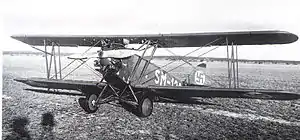Letov Š-18
The Letov Š-18 was a Czechoslovak single-engined, two-seat biplane trainer. It was designed by Alois Smolík at Letov Kbely. The Š-18 first flew in 1925.
| Letov Š-18 | |
|---|---|
 | |
| Role | Primary trainer |
| Manufacturer | Letov Kbely |
| Designer | Alois Smolík |
| Primary users | Czechoslovakian Air Force Finnish Air Force |
The aircraft was quite successful and sold well, both to private pilots and to flying clubs. Apart from the basic variant, there was also still the type Š-118, which was equipped with a Walter NZ-85 engine (85 hp, 63 KW). Some machines were exported to Bulgaria. The Czechoslovakian Air Force used the type 1925 to 1930 as a beginner trainer aircraft.
A complete reconstruction of the fuselage led to the Š-218, which had a steel tube frame and was equipped with a Walter NZ-120 engine (120 hp, 88 KW). The first flight of this type took place in 1926.
In 1929, one Š-218 Smolik was presented at Helsinki International Air Show. The Finnish Air Force showed interest in the type and purchased it in March, 1930, in order to test it. Nine more were soon ordered along with the manufacturing license. The nine aircraft ordered from Czechoslovakia arrived at Kauhava Aviation School in May–June, 1931. The Finnish State Aircraft Factory manufactured 29 slightly modified aircraft in three series. The first ten were ready in 1933, the second series of ten aircraft were ready in 1935, and nine more were in 1936. The Finnish version, which was equipped with a Bramo radial engine of 145 hp (110 kW) could develop a maximum speed of 155 km/h (83 knots, 96 mph). The type was in service with the Finnish Air Force as a primary trainer between 1930 - 1945.[1] One aircraft is still preserved at the Finnish Aviation Museum in Vantaa and one replica is being built in Finland (as of 2005).
Versions
- Letov Š-18 Walter NZ-60
- Letov Š-118 Walter NZ-85
- Letov Š-218 Walter NZ-120 or Bramo (Finnish production)
Operators
- Finnish Air Force 39 aircraft[1]
Specifications (Š-218 Smolik)
.jpg.webp)
Data from Jane's all the World's Aircraft 1928[2]
General characteristics
- Crew: 2
- Length: 6.97 m (22 ft 10 in)
- Wingspan: 10 m (32 ft 10 in)
- Height: 2.64 m (8 ft 8 in)
- Wing area: 18.64 m2 (200.6 sq ft)
- Empty weight: 470 kg (1,036 lb)
- Gross weight: 696 kg (1,534 lb)
- Powerplant: 1 × Walter NZ-120 nine-cylinder, air-cooled, radial piston engine, 89 kW (120 hp)
- Propellers: 2-bladed fixed pitch propeller
Performance
- Maximum speed: 160 km/h (99 mph, 86 kn)
- Cruise speed: 150 km/h (93 mph, 81 kn)
- Stall speed: 60 km/h (37 mph, 32 kn)
- Range: 375 km (233 mi, 202 nmi)
- Endurance: 2 hours
- Service ceiling: 4,000 m (13,000 ft)
- Time to altitude: 1,000 m (3,300 ft) in 5.7 minutes
- Wing loading: 33.7 kg/m2 (6.9 lb/sq ft)
- Power/mass: 0.1289 kW/kg (0.0784 hp/lb)
References
| Wikimedia Commons has media related to Letov Š-18. |
- Perttula, Pentti. "Backwoods Landing Strip: Finnish Air Force Aircraft". Retrieved 2009-06-28.
- Grey, C.G., ed. (1928). Jane's all the World's Aircraft 1928. London: Sampson Low, Marston & company, ltd. pp. 78c–79c.